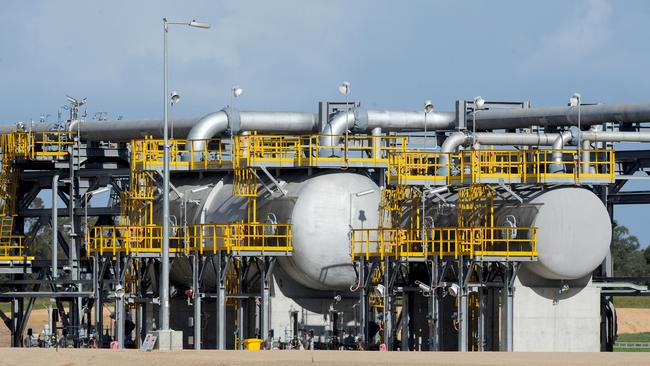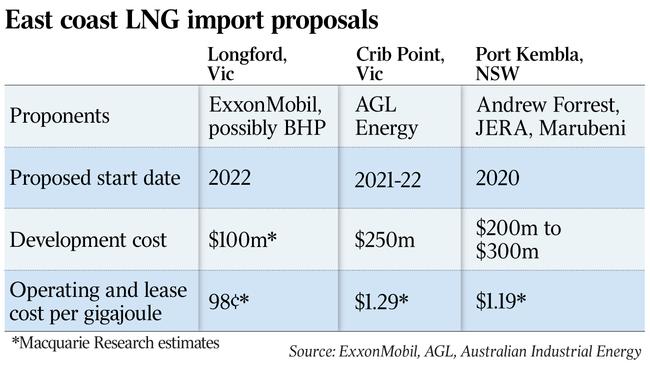ExxonMobil considering Victorian LNG import plant
Oil giant ExxonMobil is considering a Victorian LNG import plant to replace rapidly declining Bass Strait gasfields.

Oil giant ExxonMobil is considering a Victorian LNG import plant to replace rapidly declining Bass Strait gasfields, in a move that could draw in BHP to help build a floating terminal at less than half the cost of rival east coast gas import plans by AGL Energy and Andrew Forrest.
The import terminal plan, which would take advantage of existing gas infrastructure at the Longford gas plant, comes amid forecasts of a 2022 Victorian gas shortage. This comes as Exxon moves to keep market share as the southern gasfields it owns with BHP run down after 40 years as the east coast’s major supplier.
“ExxonMobil is considering a potential LNG import project that could bring additional supply into Victoria and the east coast gas network,” an Exxon spokesman told The Australian.
He said the oil major could bring world-class project experience in all areas of liquid natural gas development, production and regasification to the project.
“Combined with the existing Gippsland resource and infrastructure, an LNG import facility could ensure ExxonMobil can continue to meet our customers’ needs,” the spokesman said.
In the wake of reports of rumours of the plan by consultant EnergyQuest, Macquarie analysts estimated a Longford LNG import plant would cost $100 million, compared to announced costs of $250m from AGL and $200m to $300m from Mr Forrest’s Australian Industrial Energy.
Macquarie also expects a Longford plant to have operating costs up to 25 per cent cheaper than its rival plants, meaning it can supply gas for up to 31c less per gigajoule.
In the past year, the prospect of east coast LNG imports has switched from generally being regarded as ludicrous (given Queensland exports gas) to one where there are now three serious projects being considered by the biggest names in the Australian and international energy sectors.

LNG imports are making economic sense because east coast gas prices are exposed to international pricing after $70 billion of LNG export plants at Gladstone were built to export more gas than their proponents could develop themselves.
As a result of this and the decline of the east coast’s more cheaply produced gas, traditional prices of $3 to $4 have risen to between $8 and $10, with predictions of more price rises as international LNG markets tighten.
It’s understood Exxon has not formally decided on a location for its proposed Victorian plant.
Exxon is evaluating the project on its own. But it is understood BHP is aware of the project and plans to discuss potential involvement with Exxon.
If the project, which is in the early stages of assessment, was approved, imports could start in 2022, Exxon said.
AGL is planning first supply in 2021-22.
AIE, under the ambitious targets of Mr Forrest, and with Japanese trading house Marubeni and the world’s biggest LNG buyers Tokyo Electric Power and Chubu Electric on board, wants first imports in 2020.
Last year Exxon and BHP, partners in the Gippsland Basin joint venture that was once one of the world’s biggest oil producers, drew forecasts of east coast shortages when they told the Australian Energy Market Operator that production this year was likely to be more than one-third down on 2016 and 2017.
But even these reduced levels are unlikely to be maintained.
The pair told AEMO in March that by 2022 their production was expected to be 515 terajoules a day, or half 2018 levels,
“Without additional gas supply capacity, gas supply restrictions and curtailment would be necessary in 2022,” AEMO said in March.
The economics of LNG terminals in NSW and Victoria are making more sense as Bass Strait declines, because it costs up to $2 a gigajoule to transport gas via pipeline to Melbourne from Queensland’s coal-seam gas fields.
Freezing Queensland or foreign gas and shipping it to NSW or Victoria can be less expensive than using existing pipelines and would provide supply competition to Queensland.
Exxon is also looking to develop a small field known as West Barracouta by 2020. Further out it is hoping for a big find when it drills the big Dory prospect 90km off the Gippsland coast in the next couple of months.
But even if it discovers gas, production would be five to seven years away.
Separately last week, Exxon announced the $50m development of a new crude oil tank at its Altona oil refinery in Melbourne.
The investment comes with renewed interest in the nation’s refining and fuel sector after years of refinery closures, with Viva Energy planning a float of its Geelong refinery and associated fuel business. But it also comes as Bass Strait oil production continues to decline and Altona relies more on fuel imports from tankers.
Construction on the tank is due to start in mid-2018.

To join the conversation, please log in. Don't have an account? Register
Join the conversation, you are commenting as Logout